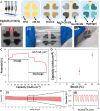Gallium-Carbon: A Universal Composite for Sustainable 3D Printing of Integrated Sensor-Heater-Battery Systems in Wearable and Recyclable Electronics
- PMID: 38878000
- PMCID: PMC11212025
- DOI: 10.1021/acsami.4c02706
Gallium-Carbon: A Universal Composite for Sustainable 3D Printing of Integrated Sensor-Heater-Battery Systems in Wearable and Recyclable Electronics
Abstract
This study presents a novel three-dimensional (3D) printable gallium-carbon black-styrene isoprene styrene block copolymer (Ga-CB-SIS), offering a versatile solution for the rapid fabrication of stretchable and integrated sensor-heater-battery systems in wearable and recyclable electronics. The composite exhibits sinter-free characteristics, allowing for printing on various substrates, including heat-sensitive materials. Unlike traditional conductive inks, the Ga-CB-SIS composite, composed of gallium, carbon black, and styrene isoprene block copolymers, combines electrical conductivity, stretchability, and digital printability. By introducing carbon black as a filler material, the composite achieves promising electromechanical behavior, making it suitable for low-resistance heaters, batteries, and electrical interconnects. The fabrication process involves a simultaneous mixing and ball-milling technique, resulting in a homogeneous composition with a CB/Ga ratio of 4.3%. The Ga-CB-SIS composite showcases remarkable adaptability for digital printing on various substrates. Its self-healing property and efficient recycling technique using a deep eutectic solvent contribute to an environmentally conscious approach to electronic waste, with a high gallium recovery efficiency of ∼98%. The study's innovation extends to applications, presenting a fully digitally printed stretchable Ga-CB-SIS battery integrated with strain sensors and heaters, representing a significant leap in LM-based composites. This multifunctional and sustainable Ga-CB-SIS composite emerges as a key player in the future of wearable electronics, offering integrated circuits with sensing, heating, and energy storage elements.
Keywords: 3D printable ink; Ga–CB–SIS ink; energy storage device; liquid metal composite; recyclable; sinter-free; strain sensor; wearable thermal devices.
Conflict of interest statement
The authors declare no competing financial interest.
Figures






References
-
- Fernandes D. F.; Majidi C.; Tavakoli M. Digitally printed stretchable electronics: a review. J. Mater. Chem. C 2019, 7 (45), 14035–14068. 10.1039/C9TC04246F. - DOI
-
- Cantarella G.; Vogt C.; Hopf R.; Münzenrieder N.; Andrianakis P.; Petti L.; Daus A.; Knobelspies S.; Büthe L.; Tröster G.; Salvatore G. A. Buckled Thin-Film Transistors and Circuits on Soft Elastomers for Stretchable Electronics. ACS Appl. Mater. Interfaces 2017, 9 (34), 28750–28757. 10.1021/acsami.7b08153. - DOI - PubMed
-
- Hajalilou A.; Silva A. F.; Lopes P. A.; Parvini E.; Majidi C.; Tavakoli M. Biphasic Liquid Metal Composites for Sinter-Free Printed Stretchable Electronics. Adv. Mater. Interfaces 2022, 9 (5), 210191310.1002/admi.202101913. - DOI
-
- Silva A. F.; Paisana H.; Fernandes T.; Góis J.; Serra A.; Coelho J. F.; de Almeida A. T.; Majidi C.; Tavakoli M. High resolution soft and stretchable circuits with PVA/liquid-metal mediated printing. Adv. Mater. Technol. 2020, 5 (9), 200034310.1002/admt.202000343. - DOI
LinkOut - more resources
Full Text Sources

